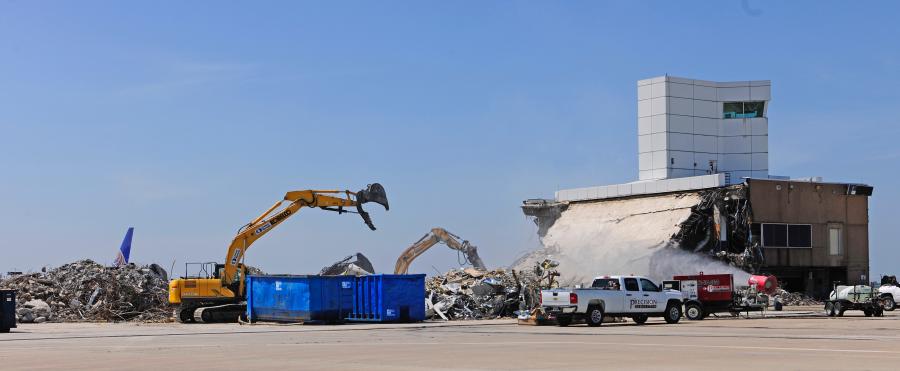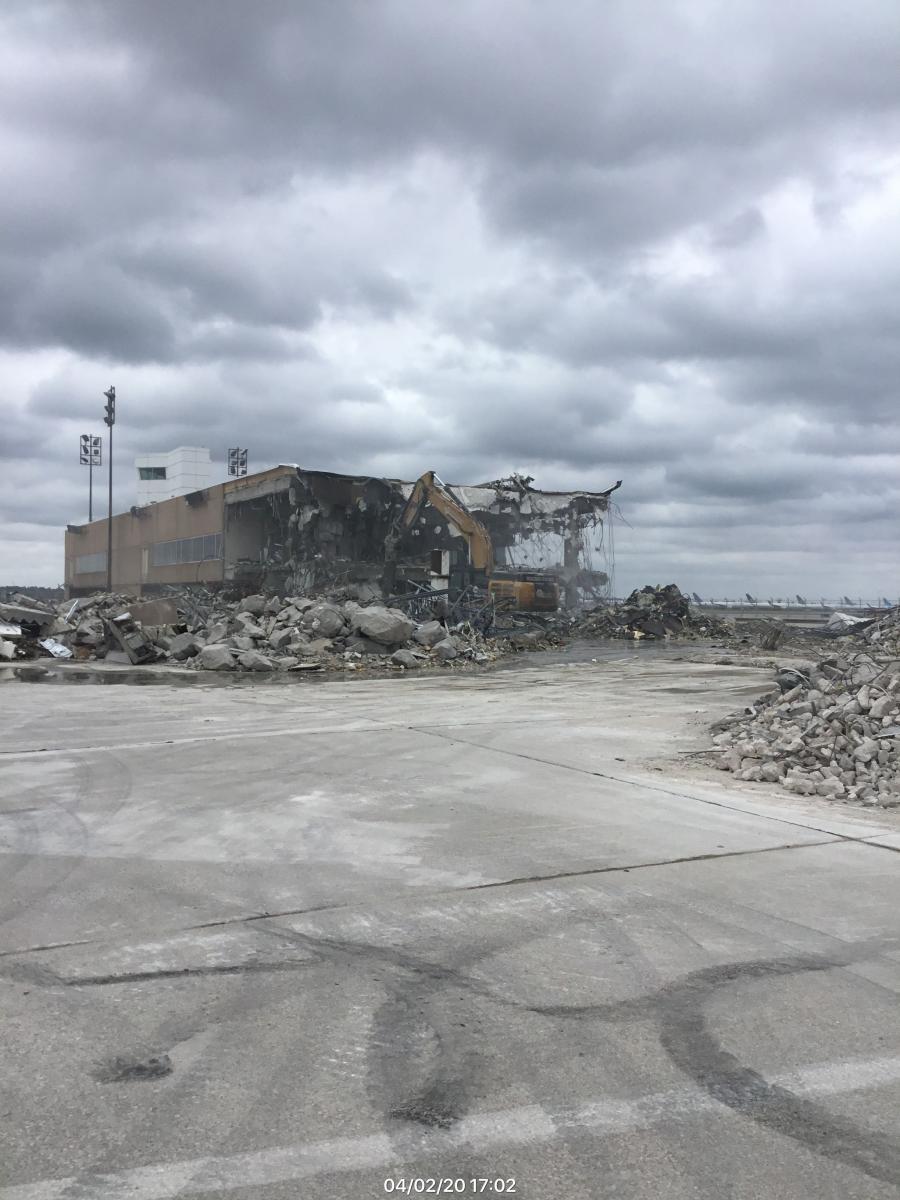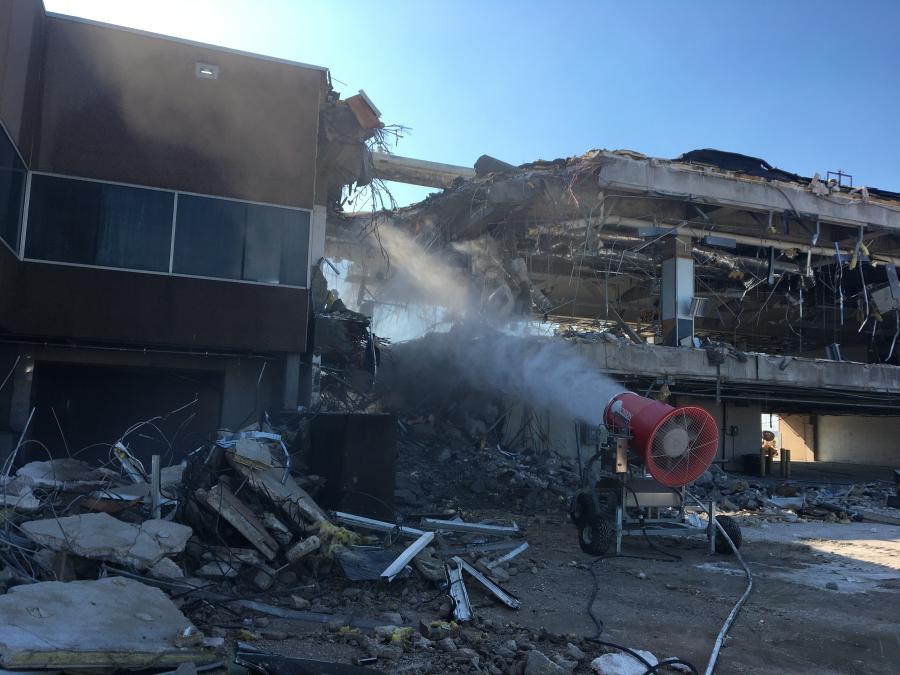A Kobelco SK210 crawler excavator was rented for four days to perform demolition work for a new international terminal at the George Bush Intercontinental Airport.
Described as possibly its most significant expansion project to date, Houston Airport System is preparing for a new international terminal, with crews from Precision Demolition currently demolishing the Old C North Terminal building at George Bush Intercontinental Airport (IAH)'s ramp. The work is a major milestone in the $1.3 billion IAH Terminal Redevelopment Program (ITRP).
The new terminal will increase the number of international gates, include new technology and provide a world-class experience for millions of passengers each year. Because of a significant decrease in air traffic due to COVID-19, ITRP can move forward with fewer logistical considerations involving aircraft arriving and departing near the construction site.
"It's critical we best utilize this time to prepare for the aviation comeback," Houston Airports Director Mario Diaz stated in a news release.
"The opening of the New International Terminal Processor is scheduled for 2024, and the completion of ITRP for 2025. This completed program goes far in maintaining the standing of our city as a top-tier international gateway to the world – with more capacity for wide-body aircrafts and amenities that will provide a passenger experience that's second to none."
A groundbreaking ceremony took place in October 2019. Since that time, progress on the demolition of Old C North Pier has been steady, with full demolition expected to be completed by summer 2020. The work has included identification and isolation of existing services, hazardous material abatement, structural assessments and the physical demolition and hauling away of the old structures. Each task was safely carried out directly adjacent to the operational Terminals C and D, as well as the IAH North aircraft movement areas.
A variety of equipment will be used during construction. Crews will use a range of heavy lifting equipment, digging and bulk shifting equipment, breaking, demolition and sawing equipment and a host of small tools for erection and on-site assembly.
Crews utilized one Caterpillar 349E hydraulic excavator w/ LaBounty MDP 30R processor; one Volvo EC460CHR excavator w/ grapple bucket; one Caterpillar 320 hydraulic excavator with grapple bucket and one Dustboss DB-60 oscillation unit to provide water. One Kobelco SK210 crawler was rented for four days to perform demolition work.
Main materials required will include concrete for foundations, structural floors and slabs, apron quality concrete, structural steel for columns, beams and roof structure, as well as external wall and glazing systems.
Project Progress
Through the 10 current ITRP prime professional services and delivery contracts, more than 70 companies are involved in day-to-day operations. Another indicator of continuing progress is that at the end of March 2020, the Houston Area Construction Education Collaborative (HACEC) provided Airport and OSHA Safety Training to 435 ITRP personnel. HACEC has successfully equipped and safely mobilized trained staff to take on complex construction activities.
The ongoing demolition of old Terminal C North will result in six new gates to fit bigger aircraft that can fly farther, creating new routes to bring in new business to Houston.
The international redevelopment plan resolves current and future roadway and curbside capacity constraints in the central terminal area, improves baggage handling system capacity and reliability challenges and improves the overall international experience for travelers.
The ITRP includes refurbishing the existing Mickey Leland International Terminal (MLIT) and demolition of the Terminal D/E parking garage to create the new International Terminal Processor between Terminals D and E, where all the international ticketing counters, security checkpoint lanes and baggage claims will be consolidated. The completed international terminal will include two concourses — one each in the current terminals — where passengers will board their planes, dine or use facilities such as airport lounges.
"ITRP is significant because it will help the Houston Airport System address the unprecedented growth in international traffic at the Bush Airport," said Robert Barker, chief development officer, Houston Airport Systems. "There is a significant need for the development of additional facilities at George Bush Intercontinental Airport [IAH] to handle aircraft, passengers and cargo departing to, and arriving from, domestic and international destinations on scheduled and chartered flights."
Almost 44 million passengers traveled through IAH in 2018, including roughly 11 million international passengers. ITRP is expected to be a catalyst for continued growth and development for decades to come.
"There is a keen appreciation that IAH must continue to thrive as a hub for commerce, travel and cultural connections," said Barker. "There's a consensus that as the city continues to grow, its largest airport must grow with it, because of its importance in connecting our city and region to both domestic and expanding international markets. The overwhelming response is a welcome recognition that a modern airport serves everyone well."
Construction Phases
The work is being carried out in phases. The first phase of ITRP was to deliver the enabling projects, the most significant being the New Terminal C Concourse (NCN), which provide the ability for new areas of construction to commence.
"A large and unique program such as ITRP demands a phased rollout," said Barker. "This approach allows us to be adaptive regarding constantly evolving technologies and other factors, such as cost, personnel, etc. The phased approach also allows opportunities to gather feedback from various stakeholders after each milestone."
The Old C North Pier is physically separated from the rest of the Terminal C public spaces with a dust wall.
"The first phase is to complete the statutory separations of the construction zone from concessions and public spaces," said Barker. "Next is to remove those parts of the building that are not tied to the post-tensioned concrete slab. For example, the North Tower and the remaining jet-bridges. The next phase is to shore up the structure slab on which the Old C North Pier is built. Once this slab is supported, the post tensioned cabling within the slab can be de-tensioned."
The structure resting on the slab can then be broken down, separated into material categories and hauled off site. Significant heavy-weight construction equipment is used to tear the building down and separate the parts for hauling away and/or recycling.
The work has required building a separation fence that forms a boundary separating the active airfield from the construction and demolition area.
"Airports and airfields have onerous requirements to separate construction activities from aircraft and normal airport operations," said Barker. "The construction fence is planned and designed with airport operations, airlines and airfield service staff to ensure that the purposes of separation will be achieved.
Many of the utilities feeding into Old C North will no longer provide any service, and once identified, can be decommissioned, separated and isolated.
"Certain utilities traverse the Old C North site, but go on to providing a utility or service to another, live area of the airport. With careful planning and engineering, these services must be protected, maintained and sometimes relocated."
Barker also explained that demolition of the D/E Garage is quite different from that of Old C North.
"The first main difference is that the D/E Garage currently houses baggage conveyors and baggage handling infrastructure. The garage cannot be demolished until this baggage equipment is re-routed away from the footprint of the area to be demolished. In addition, the garage demo is far more complex in terms of concrete and steel demolition, but not as complex for utilities, cabling, systems and ‘above ceiling' wires and piping.
"The D/E Garage is a post-tensioned concrete structure. This means that the demolition of concrete slabs and beams will require a careful de-tensioning of the existing structure, and a piece by piece removal once de-tensioned. Also, the D/E Garage is directly adjacent to the existing FIS building and Terminal E check-in areas. This requires careful removal of the structural elements to ensure no existing structures are knocked or impacted. Heavyweight, large construction equipment will be required."
The six new gates form part of the new MLIT D-West Pier. The D-West pier will be built in a location very close to the Old C North pier that's being demolished. The new gates will be housed with a modern, spacious and world-class international concourse facility.
The public facing facilities will include new restaurants and concessions, new hold rooms and restroom facilities and a sterile corridor for international arriving passengers. On the airfield, the new gates will require normal aircraft services located at each stand.
Refurbishing Existing Structures
Construction involves refurbishing other areas of the existing MLIT, as well.
"This is an important strategic goal of the program, in that we are attempting to utilize, to the largest degree possible, existing assets at the airport," said Barker. "Key areas of MLIT terminal will be refurbished to update and refresh the public spaces. This scope is to be delivered in sequence with the delivery of the new Pier D-West, due to the need to provide the additional six new gates capacity, prior to commencing intrusive construction works on the existing MLIT gates and hold-room spaces."
The airfield was designed as a flat surface, to aid the continuous and wide-reaching movement of arriving and departing aircraft.
"Airfields are, however, carefully sloped to allow for the efficient drainage of surface water," said Barker. "We are constructing a new pier, but in a slightly different location to the existing pier. We, therefore, need to address the levels around the pier, ensuring all the correct slopes are maintained.
"As this area is all existing concrete, we will need to remove, regrade and repair apron quality pavement as is necessary to create the perfect grades, so as to prevent standing apron water, or water draining toward the buildings."
Even with the steep decline in air traffic, safety remains a major concern when working in an airport setting, as well as security, airport operations, the impact to live systems and utilities, traffic and accessibility, noise, dust and foreign object debris.
Barker noted that inclement weather that includes mostly strong winds and rainfall is always an issue for construction activities outdoors.
"We plan as best we can for such events through the course of any project."
As for the most time-consuming part of the work, said Barker, "It's essential that the evolving design is fully coordinated with adjacent projects, with existing facilities and systems and continues to deliver the brief set-out by the owner and stakeholders. This takes continual collaboration and expert coordination of all architectural and engineering disciplines."
Planning construction activities also is a significant task.
"As we are working within an existing operation, with new construction taking place alongside and integral to old facilities, the construction teams will be constantly planning and re-planning their construction phasing and scheduling tasks," said Barker. "This will allow us to continually refine our short-term, medium-term and long-term milestones." CEG
Today's top stories

























